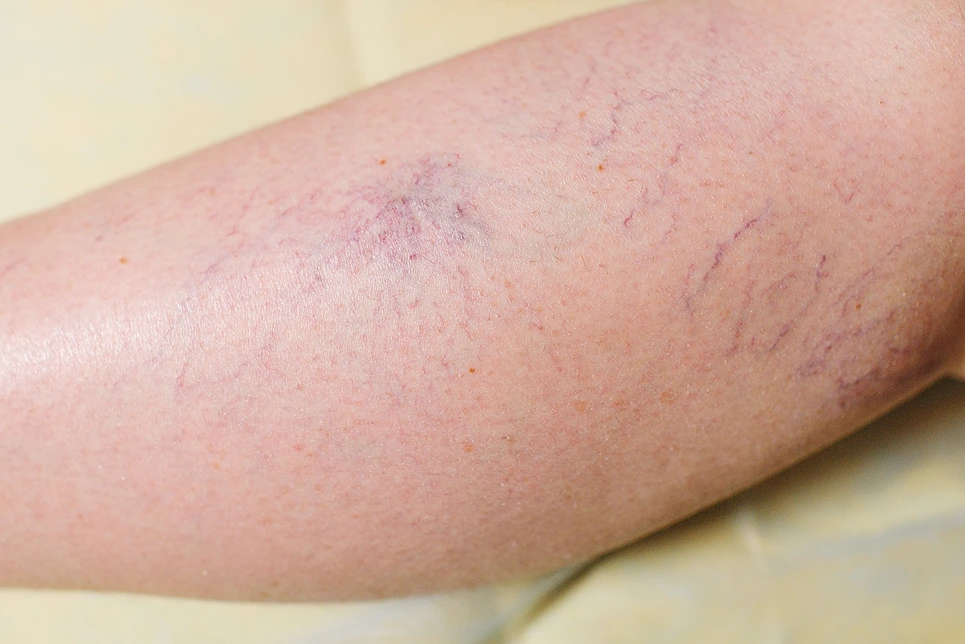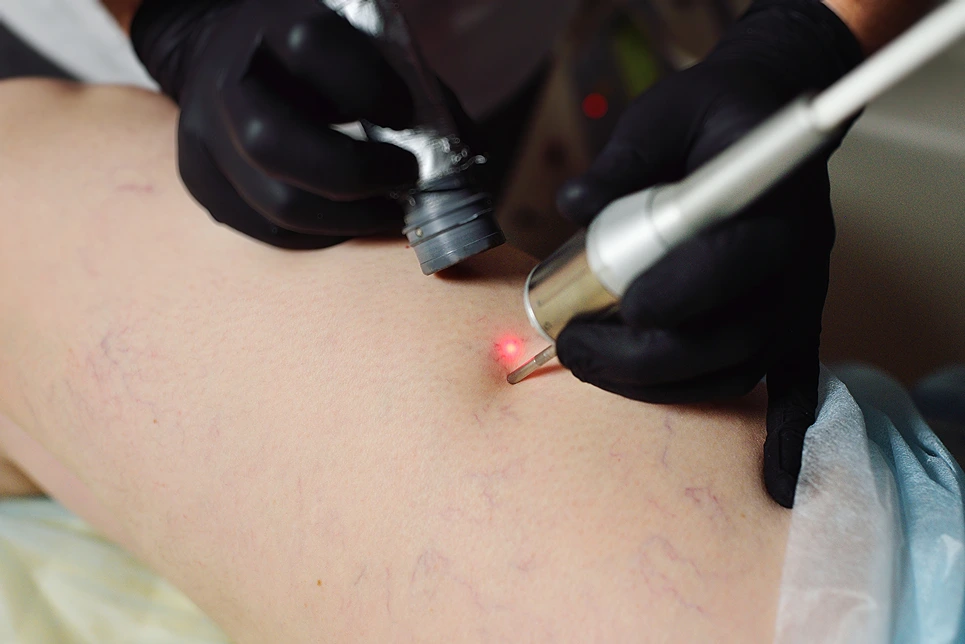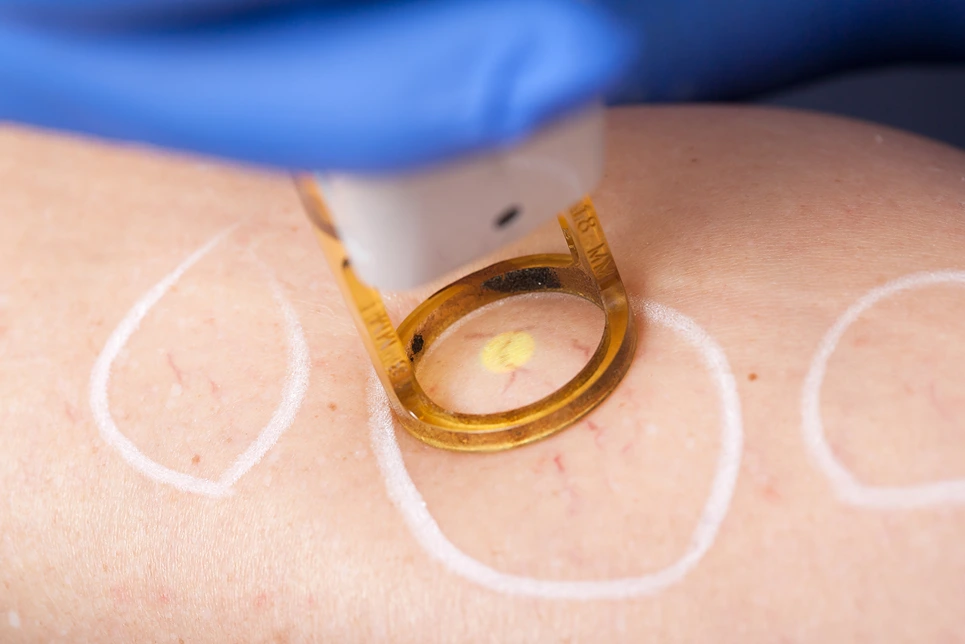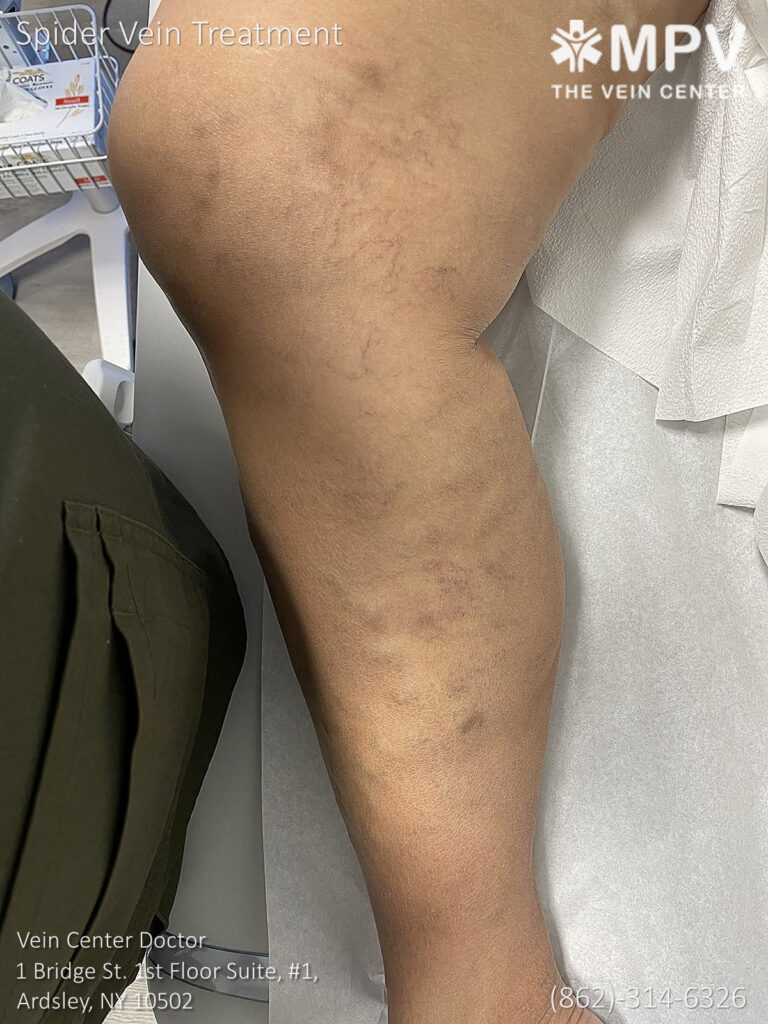Thread veins are small, visible blood vessels that appear just under the skin in a web-like or branching pattern.
They are usually red, blue, or purple and commonly show up on the legs and face, but can develop anywhere. While painless for most, some people feel discomfort or self-conscious about their appearance.
Living with unwanted veins is a thing of the past, when you can simply schedule a free consultation with Vein Center Doctor and find your ideal solution today.

Multiple factors can cause thread veins. Genetics and family history can play a role. Hormonal changes during pregnancy or menopause can cause thread veins.
Prolonged standing or sitting increases pressure on leg veins. Sun exposure damages skin and makes veins more visible. Aging reduces skin elasticity, making veins more pronounced.
Effective treatment options are available to remove or reduce the appearance of thread veins. Treatment effectiveness depends on factors like the size, location, and depth of the veins. Multiple sessions may be necessary for desired results.
Thread vein removal is generally safe when performed by a qualified specialist. A physical exam is needed to determine if the treatment is appropriate. Sclerotherapy, a common treatment for leg veins, is safe and well-established.
However, it's important to consult a healthcare provider to assess potential risks and ensure the procedure is done by a specialist.
The best method for removing thread veins depends on their location and depth. Sclerotherapy is the common treatment for leg veins and spider veins on the legs. For facial thread veins, advanced laser treatments like AFT are preferred for better results and less discomfort. Thermocoagulation is also effective for various thread veins. Consult a specialist for the most appropriate treatment.
Thread veins can spread over time, and susceptibility to new ones may emerge. Compression stockings may slow the progression, but won't stop it completely. It's important to address factors that may contribute to their development, such as maintaining a healthy BMI and avoiding tight clothing.
In conclusion, thread vein removal is safe and effective when done by experienced professionals. Various treatments are available based on the thread veins' characteristics.
Discomfort is manageable, and success rate and healing time can vary, with new thread veins possibly developing over time. Consulting a healthcare provider is essential to determine the best treatment plan and understand the risks and expected outcomes.
Several factors influence the success of thread vein removal, including vein size and depth, location on the body, skin type, color, and condition, as well as underlying health issues or medications.

Sclerotherapy is the "gold standard" for treating thread veins, especially larger ones. It involves injecting a solution directly into the veins, causing them to collapse and be reabsorbed by the body over time.
This forces blood to reroute to healthier surrounding veins. Sclerotherapy is effective but:
Laser therapy uses light beams to heat and destroy small blood vessels that form thread veins, working best on smaller, more superficial veins. Multiple treatment sessions are usually needed, spaced several weeks apart. It can cause temporary redness, swelling, or bruising.
IPL therapy uses broader spectrum light waves instead of a focused laser beam, making it less precise but able to cover larger areas at once. It may require more sessions than laser therapy to clear thread veins and has similar temporary side effects like redness and swelling.
Veinwave, a newer option, uses high frequency thermal energy waves to heat and collapse unwanted veins. It is minimally invasive and relatively painless compared to other methods. Veinwave is effective on small, superficial thread veins with minimal downtime or side effects.
The first step is scheduling a consultation with an experienced vein treatment provider. Be ready to discuss your full medical history and current medications.
The practitioner will evaluate your thread veins and make recommendations on the best treatment option. Together, you can develop a personalized treatment plan.
Before your first treatment, you may be told to avoid excessive sun exposure or tanning for weeks. Your provider may recommend temporarily stopping blood-thinning medications if safe. On the treatment day, wear loose, comfortable clothing and arrange for a driver if sedation is needed.
Thread vein removal can be uncomfortable but generally tolerable. Sclerotherapy may not be painful depending on the solution used.
Advanced laser treatments like AFT may cause a sensation similar to a hot elastic-band flick, but cooling tips are used to reduce heat. Discuss pain management options with the provider before treatment.
Thread vein removal success varies. Results depend on the treatment. Most clinics recommend four AFT sessions for optimal results. Small vessels are absorbed over three months and should not reappear. However, the treatment may have little or no effect in some cases.
Thread vein removal treatments take 30-60 minutes, depending on the areas treated. Expect minor stinging, snapping, or heating sensations. Cooling gels or local anesthesia may be used for comfort.
After treatment, it's normal to have redness, swelling, bruising, or tenderness in the treated area, which should resolve within a few days to a week. Your provider may suggest wearing compression stockings to reduce swelling and promote healing, especially for leg vein treatments.
Follow post-care instructions, like avoiding strenuous activities, hot baths, saunas, or extended sun exposure for a specified period. This helps the treated veins to heal and seal off. Not following guidelines could lead to complications or reduce the results.

You should start seeing an improvement in the appearance of thread veins within 3-6 weeks after your first treatment. However, it may take several months and multiple spaced-out treatments for full results. Be patient and let the healing process occur between appointments.
Treatment can remove thread veins, but they can redevelop. To maintain results and prevent new ones, follow these tips:
The healing time for thread vein removal varies. It takes about 1 year for the treated vein to disappear with EVLT and RFA.
Sclerotherapy results can be seen at two to three months after the first treatment, and the legs may feel tender for the first few days. No downtime is involved with AFT treatment, but skin care is important before and after the procedure.
When choosing a thread vein treatment provider, look for medical professionals with proper training, certification, and experience in vein procedures. Check their credentials and patient reviews. Before-and-after photo galleries can help evaluate their skill level.
Consider a clinic location convenient for all appointments with flexible scheduling to accommodate your availability. Factors like parking, public transit access and office hours can impact convenience.
Most patients experience mild discomfort during and after treatment. Numbing creams and cooling methods help minimize pain. Any discomfort is brief and manageable.
The number of sessions needed varies based on the extent of thread veins and your response. Many see results after 2-4 sessions spaced several weeks apart, but some may need more.
Thread vein removal results can be long-lasting, but not permanent. New veins can form over time, especially with sun exposure or weight/hormone changes. Maintenance treatments may be needed.
Common temporary side effects include bruising, redness, and swelling. Rare risks are skin discoloration, scarring, or new thread veins. Following post-care instructions minimizes complications.
Most insurance providers consider this a cosmetic procedure and do not cover it. However, it may be covered if deemed medically necessary for treating venous insufficiency or other conditions.

Thread vein removal isn't a medical necessity, but it can offer a cosmetic solution for those bothered by visible veins. Sclerotherapy, laser therapy, IPL, and newer techniques like Veinwave are safe and effective ways to diminish thread veins on the face, legs, or body.
Work closely with an experienced vein specialist to develop the right treatment plan for your needs. Follow pre and post-care instructions for optimal results. With proper treatment and maintenance, you can keep thread veins at bay long-term and feel more confident.
Find exactly what you need to get rid of your vein-related problems. Dr. Sood and the rest of our team at Vein Center Doctor are ready to help: schedule your free consultation today.
Most Insurance is accepted for treatment